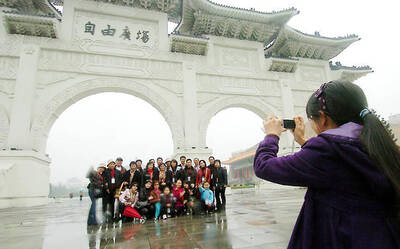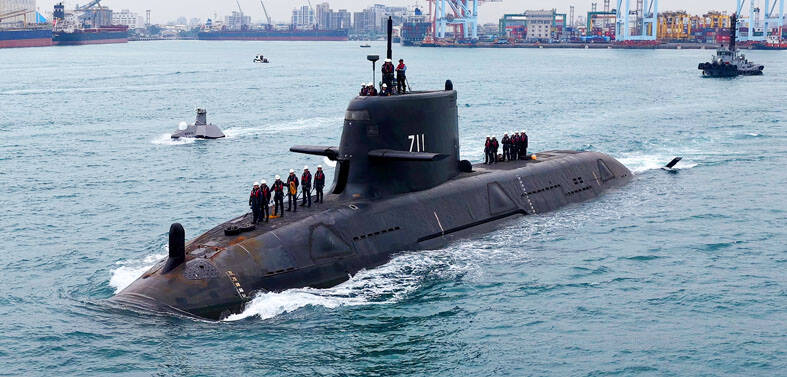The Presidential Office last week quickly corrected an “error” made after a meeting between President Ma Ying-jeou (馬英九) and US Representative James Sensenbrenner Jr. The “error” came in a post-衫eeting press release that quoted Ma as referring to the two sides of the Taiwan Strait as “nations.” It was later changed to “two areas” on the Presidential Office Web site.
The following day, Presidential Office Spokesman Wang Yu-chi (王郁琦) told reporters that Ma would never make such a “mistake” and reaffirmed the administration’s adherence to the Republic of China (ROC) Constitution, which, when taken literally — as Wang did — signifies that China is an “area” of the ROC. Wang also underscored that Taipei does not recognize the sovereignty of the Chinese Communist Party.
The use of “areas” to describe Taiwan and China, he said, reflected the longstanding “status quo” in the Taiwan Strait and was followed by the administrations of former presidents Lee Teng-hui (李登輝) and Chen Shui-bian (陳水扁).
This last characterization, however, masks a far more complex shift in Taiwan that began in 1991 with what authors Bruce Jacobs and I-hao Ben Liu describe in their paper Lee Teng-hui and the Idea of Taiwan as the recognition by the ROC on Taiwan “that it did not control the Chinese mainland.” In other words, Lee sought to fix Taiwan as the limit of the ROC’s jurisdiction. This would lead to six constitutional amendments under Lee, changes to the final clause of the first phase of the National Unification Guidelines (國家統一綱領) and the termination of the Temporary Provisions Effective during the Period of National Mobilization for the Suppression of the Communist Rebellion (動員勘亂時期臨時條款).
This culminated with the announcement by Lee during an interview in July 1999 that cross-strait relations are “special state-to-state relations.”
In the following days, various polls showed strong public support for Lee’s statement, with a survey by the Chinese Nationalist Party (KMT) Institute on Policy Research and Development showing 60.9 percent of respondents agreeing (32.3 percent agreeing very much) against 26.6 percent who disagreed.
This statement was made amid efforts by Lee’s administration, with the participation of academics and officials from the Democratic Progressive Party (DPP) — including future DPP Chairperson Tsai Ing-wen (蔡英文) — to flesh out what came to be known as the Two-State Theory. Chen later picked up the momentum of this with references to “one country on each side.”
OBFUSCATION
Analysts see Wang’s papering over the orthodoxy reversal that occurred under Lee and Chen as an attempt by the Ma administration to turn back the clock.
“This throws Taiwan back to the pre-1991 period, when the KMT still considered itself the legitimate ruler of all China. Lee Teng-hui and Chen Shui-bian gradually brought Taiwan into the present reality, but the statements from the Ma administration represent a return to the fiction of the old ROC,” Gerrit van der Wees, editor of Taiwan Communique, told the Taipei Times.
John Tkacik, a retired US foreign service officer, lamented that “Ma seems to be leading Taiwanese into a fight with China about which side is the ‘real China,’” a fight that Taiwan “is sure to lose.”
“Presidents Lee and Chen wanted to keep Taiwan out of that fight for the same reason — they, too, knew that Taiwan was sure to lose,” he said via e-mail.
This isn’t to say that Ma’s predecessors — especially Lee — didn’t engage in back-and-forth policies regarding Taiwan’s sovereign status. In fact, while Lee was gradually shifting on Taiwan’s status, he acted cautiously and continued to advocate unification and to claim that Taiwan and China were two “regions” of the ROC.
Still, as Jacobs and Liu observe, “Lee said ‘yes’ to unification so he could not be attacked for refusing, but his strategy of gradualism enabled him to remain flexible and to adapt his ideas and actions as he felt necessary.”
The need for caution stemmed from the mainlander elite in Taiwan and within his party — the same group that may be pressuring Ma today — as well as the exigencies of not “provoking” Beijing. As such, while key documents were amended, Lee’s advocacy of a state-to-state relationship remained mostly in the rhetorical sphere.
CONSTITUTION
What was needed to turn words into action were either a series of substantive constitutional amendments, or a new Constitution.
“The key is to discard the ROC Constitution and replace it with a new Taiwanese constitution. [This] is the only way to clearly cut off the Ma/KMT fantasy once and for all and free Taiwan from this last connecting thread with China,” Sebo Koh, a member of the Central Committee of World United Formosans for Independence and a spokesman for the World Taiwanese Congress, told the Taipei Times.
As Lee wrote in his foreword to A New Constitution for Taiwan — a collection of papers 計resented during the Symposium on a New Constitution for Taiwan at Taipei’s Grand Hotel in November 2004: “With a growing sense of national identity, more and more Taiwan people agree with the necessity to abandon the current Constitution, one that the Taiwan people had not participated in the making of, in favor of establishing [a constitution] that would meet Taiwan’s current needs.”
In his opening address at the symposium, Chen said: “It is our duty to the great freedom-loving Taiwanese people … to create a Taiwan constitution that meets the needs of the present times and our current circumstances.”
The current Constitution, he said, “is now unable to meet the needs of the Taiwan people in their current stage of development.”
While there was a certain momentum for a new Constitution, “with democratization and the Taiwanese independent movement compelled to accommodate elections strategies, the new constitution movement was largely cast aside and could not gain much traction,” Koh said.
Many Taiwanese supported a change to the Constitution, but few believed it was worth spending too much political capital on the project, especially after Beijing — and Washington — warned Chen against moving toward “de jure independence” through amendments or the adoption of a new Constitution. With Beijing’s threats of war, caution for the sake of domestic politics, or lack of interest, were replaced by fear, which further undermined efforts to change the Constitution.
By then, the subject had become “toxic,” Koh said.
As Lee Yung-chih (李永熾), a professor of history at National Taiwan University (NTU), told the symposium, “the people of Taiwan, haunted by the specter of subjugation by the People’s Republic of China and under threat from its weapons, haven’t dared to 訃ecognize themselves as Taiwanese, posing instead as the ‘people of the Republic of China.’”
BACK IN TIME
During a speech at a symposium titled “The Growth of Constitutional Democracy and Its Challenges” held by the National Policy Foundation at NTU in 2006, Ma was already giving us a taste of his future policies as president, saying: “There is no urgency for amending the Constitution. What’s truly important is to observe and implement the Constitution,” meaning the ROC Constitution.
Earlier that year, he had warned Chen against writing a new Constitution.
During the more than two decades covered in this article, an increasing number of people in Taiwan have identified themselves as Taiwanese. Support for Taiwanese independence also rose, reaching 23.5 percent — the highest in 12 years — last year, while support for unification with China fell to 6.5 percent, the lowest in the same period. Support for the “status quo,” meanwhile, stood at 57.8 percent. These numbers highlight the fact that while the majority continues to support the “status quo,” Taiwanese identity and support for independence have increased, while Chinese identification and support for unification have both dropped.
Although there is no exact correlation between rising national identity and agreement with the proposition that cross-strait relations are between states, this phenomenon nevertheless shows that Ma’s attempts to return to an unreformed ROC Constitution go against popular sentiment and current reality. It is, in fact, a form of revisionism and a negation of more than two decades of gradual change.
“The Ma government seems to be stuck in pre-history and has not been part of Taiwan’s political evolution over the past three decades,” van der Wees said.

US climber Alex Honnold is to attempt to scale Taipei 101 without a rope and harness in a live Netflix special on Jan. 24, the streaming platform announced on Wednesday. Accounting for the time difference, the two-hour broadcast of Honnold’s climb, called Skyscraper Live, is to air on Jan. 23 in the US, Netflix said in a statement. Honnold, 40, was the first person ever to free solo climb the 900m El Capitan rock formation in Yosemite National Park — a feat that was recorded and later made into the 2018 documentary film Free Solo. Netflix previewed Skyscraper Live in October, after videos

NUMBERS IMBALANCE: More than 4 million Taiwanese have visited China this year, while only about half a million Chinese have visited here Beijing has yet to respond to Taiwan’s requests for negotiation over matters related to the recovery of cross-strait tourism, the Tourism Administration said yesterday. Taiwan’s tourism authority issued the statement after Chinese-language daily the China Times reported yesterday that the government’s policy of banning group tours to China does not stop Taiwanese from visiting the country. As of October, more than 4.2 million had traveled to China this year, exceeding last year. Beijing estimated the number of Taiwanese tourists in China could reach 4.5 million this year. By contrast, only 500,000 Chinese tourists are expected in Taiwan, the report said. The report

Temperatures are forecast to drop steadily as a continental cold air mass moves across Taiwan, with some areas also likely to see heavy rainfall, the Central Weather Administration (CWA) said. From today through early tomorrow, a cold air mass would keep temperatures low across central and northern Taiwan, and the eastern half of Taiwan proper, with isolated brief showers forecast along Keelung’s north coast, Taipei and New Taipei City’s mountainous areas and eastern Taiwan, it said. Lows of 11°C to 15°C are forecast in central and northern Taiwan, Yilan County, and the outlying Kinmen and Lienchiang (Matsu) counties, and 14°C to 17°C

STEERING FAILURE: The first boat of its class is experiencing teething issues as it readies for acceptance by the navy, according to a recent story about rudder failure The Hai Kun (海鯤), the nation’s first locally built submarine, allegedly suffered a total failure of stern hydraulic systems during the second round of sea acceptance trials on June 26, and sailors were forced to manually operate the X-rudder to turn the submarine and return to port, news Web site Mirror Daily reported yesterday. The report said that tugboats following the Hai Kun assisted the submarine in avoiding collisions with other ships due to the X-rudder malfunctioning. At the time of the report, the submarine had completed its trials and was scheduled to begin diving and surfacing tests in shallow areas. The X-rudder,